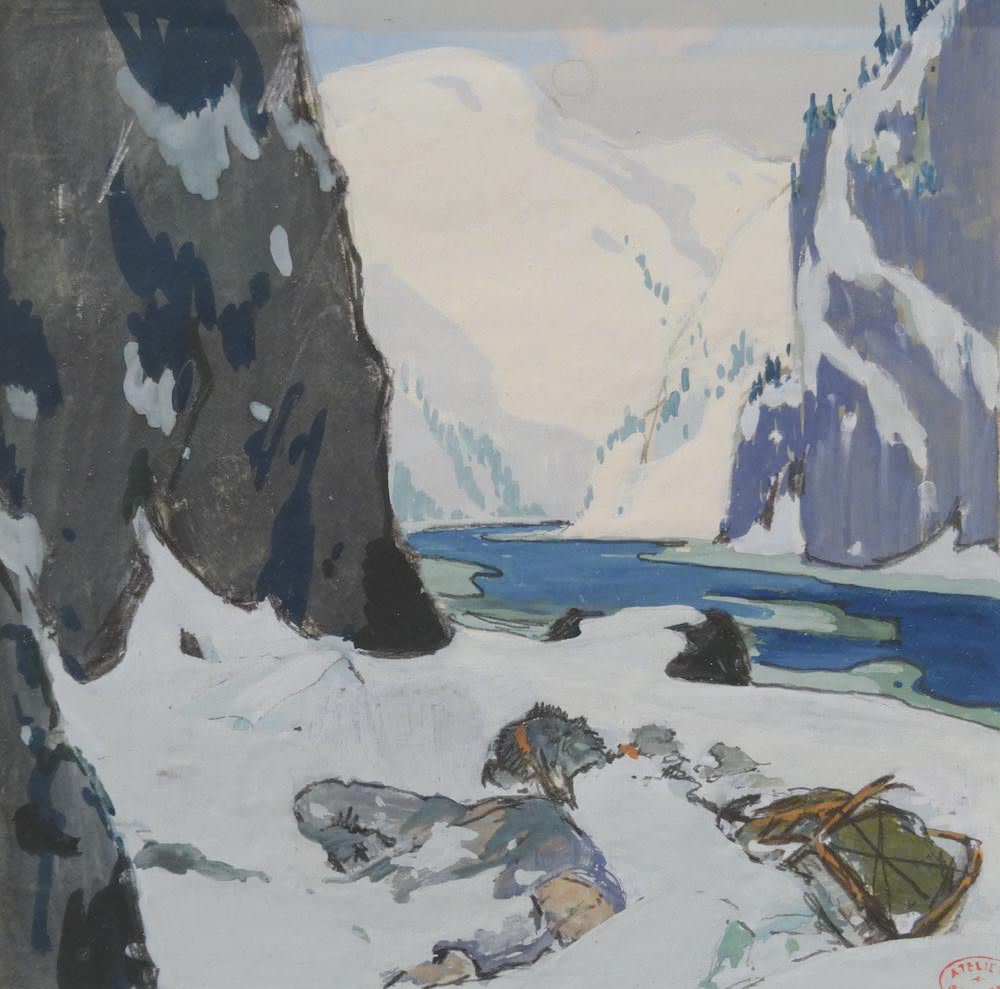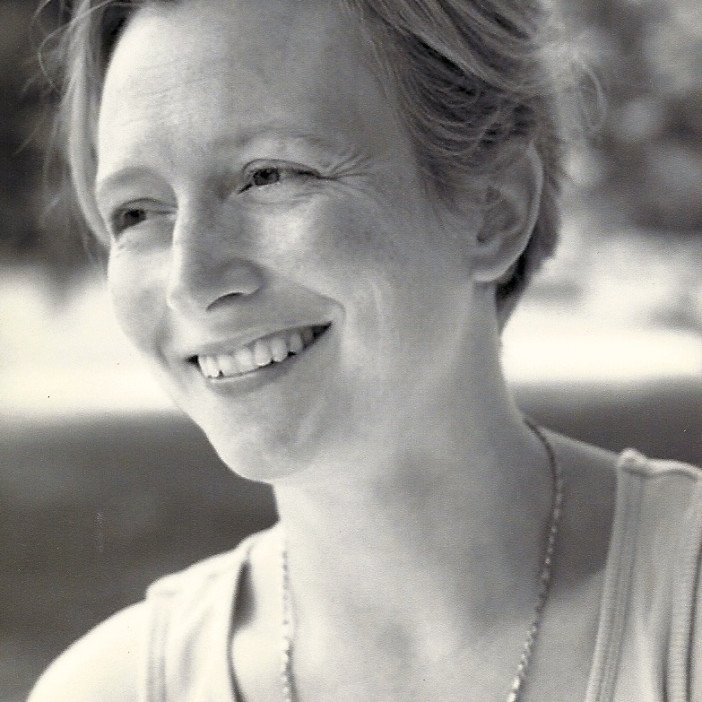Precious Illustration, an Important Visual Document in the Narrative Of Clarence Gagnon
We introduce below an especially fine preliminary study of what would ultimately be developed into an illustration for Le Grand Silence Blanc (on page 168). The work is aesthetically precious, an important visual document in the narrative of Clarence Gagnon and announced the first “official inauguration” of Canadian art in France, in 1927 at Paris’, "Exposition d'art canadien, Musée du Jeu de Paume".

Detail of an illustration from Le Grand Silence Blanc, page 168
gouache or similar opaque water based medium on a sheet of typewriter paper, size 6” x 6”
Le Grand Silence Blanc
A block of ice falls crushing 5 of Hans’ 6 Labradors and leaves Hans unconscious.
In Chapter XIII, the narrator tells the story of a certain Hans Troemsen and on page 168, the image depicts a scene in the book where Troemsen, a man described as a tall blond Scandinavian, silent, grave and modest fisherman turned traveler has an accident with his team of six Labrador sleigh dogs when crossing the White Pass gorges on a trip from Skagway to White Horse. A heavy crack sound resonates in the gorges and a block of ice falls on the team in which five of the dogs are crushed and Hans’ head hits a rock and leaves him in an unconscious state. Hans is left with an open wound, alone with his dog Wheeler who comes to his rescue and licks his blood. Hans is lucky and is rescued by the mail stage and both him and the dog are carried off to Dawson and he eventually recovers. Through this experience, a close bond is kindled between Hans and sleigh dog Wheeler.
In the illustration, sleigh dog Wheeler is seen howling as if echoing in the enormity of the Far North. The image shows the observer the importance of a relationship between a man and his dog, especially in the North, as they come to rely on each other for survival. This theme resurfaces by the end of the chapter, as the reader learns that Hans Troemsen is murdered by Ralph Harrisson, fellow traveler and ‘bad boy’, on a second trip in the North over a gold seeking agreement. Ralph is unveiled as his murderer by Push, Hans inseparable dog, and is hanged for his crime and betrayal. Troemsen’s story and the picture on page 168 denotes how solitude and a likelihood of peril are central themes to the story and are embedded in every aspect of an explorer’s journey. It also might intend to convey how the beauty and vastness of the Far North and its treasures may lure its inhabitants with a false sense of security. For example, in Chapter XII, page 156, the narrator maintains “ [they] were so consumed by gold fever that for a little while, [they] seemed to have forgotten the severe conditions of the Far North…”
What is particularly interesting about this illustration is that it is hand painted in gouache or similar opaque water based medium on a sheet of typewriter paper. On the reverse is a typed text written on the behalf of the curators of the famous 1927 exhibition of Canadian art at Paris’ Musée du Jeu de Paume, signed by Eric Brown, Director of The National Gallery of Canada and on behalf of the curators of the Jeu de Paume exhibition those being really just he and Gagnon . The text reads that they were giving the recipient two invitation cards for the April 11 opening and that he would be available to give them a preview from the 9th. In this exhibition were included 4 oil paintings by Gagnon, 3 of his etchings and 13 monotypes for Le Grand Silence Blanc (framed as an ensemble see fig. 73 Clarence A Gagnon, Dreaming the Landscape). Le Grand Silence Blanc was to be published in March of 1928.
Compositionally, it is noteworthy that whereas in the actual composition Gagnon reproduced in Le Grand Silence Blanc, Wheeler is described as a stronger survivor of the ice fall, in this study he painted up for an invitation facsimile Wheeler is shown quite frail, maybe shaking off the trauma before a recovery.
Presumably what we have is a prototype of an invitation Gagnon and the curator, of the Jeu de Paume exhibition, essentially Eric Brown and himself, were working on to stimulate interest in the 1927 exhibition. I say prototype because as the plan of schedule evolved the exhibition opened on April 10, not the 11th as indicated on the back of our drawing. Boissay actually notes that the director of the Jeu de Paume put off the opening date twice.
The circumstances leading up to the Jeu de Paume exhibition, the exhibition itself and the post mortem are well described in Clarence Gagnon by Rene Boissay édition Héritage Broquet, Ottawa, 1988 and make for wonderful recollection. Boissay writes that the 1925 Wembley show being such a success, Eric Brown convinced Gagnon that because of his excellent Paris contacts he should assist in organizing a similar Wembley style exhibition in Paris at either the Petit Palais or the Jeu de Paume. The resulting Exposition d'art canadien, in Paris included both a Tom Thomson retrospective and a retrospective of James Wilson Morrice with the entire exhibition comprised of some 250 works of Canadian art. Boissay writes that “(Exposition d'art canadien, )... was the first official inauguration of Canadian art in France...” the French press and Paris based correspondents from all over the world wrote about this exhibition giving it extensive coverage, while only Canadian papers with a correspondent in Paris did so. Surprisingly, the one Canadian correspondent in Paris who worked for the Canadian Press Agency overlooked the exhibition!” (page 157)
In conclusion, we are of the opinion that this is not only an exquisite example of the draughtsmanship and poetry in this medium by Clarence A Gagnon but also a testimony to his contribution to the promotion of Canadian art outside of Canada.
Dr. Sarah Stanners, Ph.D. (November 2014, Toronto)





Add a comment